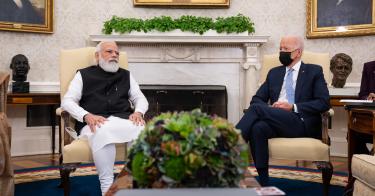On June 22, Indian Prime Minister Narendra Modi will make his first State visit to the United States. Visits to the U.S. by foreign leaders come in several varieties—private visits; working visits; official workings visits; official visits; state visits—each with distinct diplomatic protocols. A state visit is the highest honor, replete with a 21-gun salute, a white tie dinner, and sometimes an address to a joint session of Congress. In the 75 years of diplomatic relations between India and the U.S., there have been only two other state visits by Indian leaders: President Sarvepalli Radhakrishnan in 1963 and Prime Minister Manmohan Singh in 2009.[i]
The transformation of the India–U.S. relationship has been one of the rare bipartisan foreign policy successes of the 21st century. Nearly 20 years after the George W. Bush administration substantially upgraded bilateral ties, the scope of cooperation between the two countries is dizzying.
On June 22, Indian Prime Minister Narendra Modi will make his first State visit to the United States. Visits to the U.S. by foreign leaders come in several varieties—private visits; working visits; official workings visits; official visits; state visits—each with distinct diplomatic protocols. A state visit is the highest honor, replete with a 21-gun salute, a white tie dinner, and sometimes an address to a joint session of Congress. In the 75 years of diplomatic relations between India and the U.S., there have been only two other state visits by Indian leaders: President Sarvepalli Radhakrishnan in 1963 and Prime Minister Manmohan Singh in 2009.[i]
The transformation of the India–U.S. relationship has been one of the rare bipartisan foreign policy successes of the 21st century. Nearly 20 years after the George W. Bush administration substantially upgraded bilateral ties, the scope of cooperation between the two countries is dizzying.
Modi Comes to Washington
After the Trump administration took major strides forward with India—including signing several foundational military pacts and reviving the Quad grouping—the Biden administration has wisely opted to maintain continuity in the relationship. But there is more to be done. Congress and the Biden administration should use the opportunity of Modi’s state visit to:
1. Pass a Joint Resolution of Congress.
House Speaker Kevin McCarthy has extended a rare invitation for Modi to address a joint session of Congress. This will be Modi’s second such address, after telling a joint session of Congress in June 2018 that the “the traits of freedom and liberty form a strong bond between our two democracies.”[vii] Congress should go one step further, passing a joint resolution that reaffirms the bipartisan nature of support for India–U.S. ties and reinforces the idea that: (a.) India–U.S. ties remain the defining partnership of the 21st century; (b.) it is inherently in America’s interest for India to develop the military and economic capabilities to serve as a leading power in the region and a net provider of security in the Indian Ocean; (c.) there is bipartisan support for taking defense ties to the next level, including co-development and co-production of military platforms, and (d.) Congress sees the Quad grouping as a vital component of the Indo-Pacific security landscape and its success as a vital U.S. national interest.
2. Advance Defense Collaboration to include co-production.
The Biden administration should approve a new agreement under review to produce fighter jet engines in India. India is purchasing roughly 100 U.S.-made F414 jet engines to power its Tejas fighter aircraft and the Biden administration is reviewing a pact to that will allow more of the engines to be produced domestically in India, increasing the technology transfer involved. The United States has been trying to position itself as an alternative to India’s traditional defense patron, Russia, which will require more intimate collaboration in advanced defense hardware.
Talks are also underway to sell India dozens of MQ-9 Sea Guardian armed drones, with progress expected to be announced during Modi's visit. Finally, the two sides have been in talks to co-produce a new extended-range variant of the M777 howitzer artillery. India has already purchased 145 howitzers and some of its components, including titanium castings, are already produced in India. (Since a China-India border crisis in 2020, New Delhi has deployed some of its howitzers to the China border, just as it has used American transport aircraft to resupply its mountain positions and used American surveillance aircraft to track Chinese submarines in the Indian Ocean).
The Biden administration should approve the jet engine deal and another pending deal to sell India unmanned aerial vehicles as well as signal progress on a howitzer co-production arrangement.
3. Put a trade deal back on the table.
The India-U.S. relationship witnessed substantial growth under the Trump administration but, regrettably, the two sides failed to reach agreement on a new trade and investment pact despite years of negotiations. While bilateral trade flows are growing at a healthy rate, there are untapped opportunities on the table and potential roadblocks emerging on the horizon. In the near term, the two sides need to register some progress in negotiations on data localization and e-commerce, market access, and government subsidies.
As the two giant Indo-Pacific economies outside the major regional multilateral trade agreements—the Trans-Pacific Partnership (TPP) and Regional Comprehensive Economic Cooperation Agreement (RCEP)—India and the U.S. must forge their own path and lead jointly in setting new standards and adopting best trade practices. Even a limited bilateral trade and investment deal could set a positive template and pave the way for additional progress in the years ahead. To date, the Biden administration has shown little interest in pursuing such a deal, instead working to involve India in its new but still amorphous Indo-Pacific Economic Framework (IPEF).[xi]
4. Critical Supply chain cooperation.
India and the U.S. have begun ramping up dialogues on supply chains, including through bilateral avenues, the Quad, and the IPEF. The 14 countries of the IPEF reportedly reached a tentative agreement in May 2023 on improving supply chain resilience. The partnership will focus on mutual support during supply chain shortages like those seen during COVID-19, including simpler customs clearances. It also involves vague pledges to reduce trade restrictions and expand investment and research into supply chain diversification.[xii]A worthy initiative, but as is often the case, the devil will be in the details.
In the meantime, the U.S. should prioritize bilateral efforts to boost Indian integration into U.S. supply chains, particularly for products critical to U.S. economic vitality and national security that are currently exclusively or heavily sourced from China. Pharmaceuticals and critical minerals represent two natural opportunities.[xiii] The U.S. should also be encouraging companies departing the volatile Chinese market to “friendshore” to India, where viable. The Indian government has a unique opportunity to attract new investment with a mounting restructuring of global supply chains and selective flight from the Chinese market. However, to fully take advantage of these opportunities, New Delhi must continue to pursue what can be politically contentious economic reforms. If the Biden administration announced a new bilateral initiative on supply chain resilience led by a senior cabinet official, it could go a long way.
5. The China border and Taiwan.
India, the only member of the Quad with a disputed border with China, has been facing pressure from the Chinese military along the Line of Actual Control. The United States should reaffirm its support for Indian sovereignty, condemn Chinese attempts to change the status quo at the border, and restate that it is in America’s interest to help India develop a modern military capable of positioning India as a net provider of security in the Indian Ocean region. The U.S. should also reaffirm that it recognizes Arunachal Pradesh, over which China claims some 50,000 square miles, as an Indian state and the international border as settled, as has been official U.S. policy since 1962. It should make clear that any Chinese encroachment into Arunachal Pradesh would not be treated as a conflict in an ambiguous disputed area, but aggression across a settled intentional border.[xiv]
In turn, the U.S. should encourage India to make statements of support on other key issues, including Taiwan and the importance of freedom of navigation.[xv] India has been slowly expanding diplomatic and economic relations with Taiwan, but it has generally been reluctant to criticize China’s aggressive statements and actions toward the self-governed island. Even a statement from New Delhi to the effect that “peace and stability in the Taiwan Strait is in the national interest of India” would send a positive signal to Taiwan and to the region. Strong statements of support for the Quad from Prime Minister Modi should also be welcomed.
Notes:
[i] “Visits By Foreign Leaders of India,” Office of the Historian, https://history.state.gov/departmenthistory/visits/india
[ii] Press release, “Joint Statement of India-U.S. Commercial Dialogue,” U.S. Department of Commerce, March 14, 2023, https://www.commerce.gov/news/press-releases/2023/03/joint-statement-india-us-commercial-dialogue#:~:text=The%20Minister%20and%20the%20Secretary,accelerated%20growth%20benefitting%20both%20countries.
[iii] Press release, U.S. Department of Commerce, “Joint Statement of India-U.S. Commercial Dialogue,” March 14, 2023, https://www.commerce.gov/news/press-releases/2023/03/joint-statement-india-us-commercial-dialogue
[iv]“Fact Sheet: United States and India Elevate Strategic Partnership with the initiative on Critical and Emerging Technology (iCET),” The White House, January 31, 2023, https://www.whitehouse.gov/briefing-room/statements-releases/2023/01/31/fact-sheet-united-states-and-india-elevate-strategic-partnership-with-the-initiative-on-critical-and-emerging-technology-icet/
[v] “Joint Statement of the Leaders of India, Israel, United Arab Emirates, and the United States (I2U2),” The White House, July 14, 2022, https://www.whitehouse.gov/briefing-room/statements-releases/2022/07/14/joint-statement-of-the-leaders-of-india-israel-united-arab-emirates-and-the-united-states-i2u2/
[vi] Mohammed Soliman, “In Saudi, US embraces a West Asia architecture with India, UAE,” May 13, 2023, Al-Monitor, https://www.al-monitor.com/originals/2023/05/saudi-us-embraces-west-asia-architecture-india-uae#ixzz83DaR1jnD
[vii] Nicole Gaouette and Elise Labott, “Modi addresses Congress as U.S.-India ties bloom,” CNN, June 9, 2016, https://www.cnn.com/2016/06/08/politics/modi-speech-u-s-congress-visit/index.html
[viii] Press release, “GE F414 Engines Selected to Power India Light Combat Aircraft Program,” General Electric, October 1, 2010, https://www.ge.com/news/press-releases/ge-f414-engines-selected-power-india-light-combat-aircraft-program
[ix] Ibid, “Fact Sheet: United States and India Elevate Strategic Partnership with the initiative on Critical and Emerging Technology (iCET).”
[x] “Readout of Deputy Secretary of Defense Dr. Kathleen Hicks' Meeting with Indian Defence Secretary Giridhar Aramane,” U.S. Department of Defense, May 18, 2023, https://www.defense.gov/News/Releases/Release/Article/3399988/readout-of-deputy-secretary-of-defense-dr-kathleen-hicks-meeting-with-indian-de/
[xi] Indo- Pacific Strategy,” The White House, February 2022, https://www.whitehouse.gov/wp-content/uploads/2022/02/U.S.-Indo-Pacific-Strategy.pdf
[xii] Press release, “IPEF Joint Statement for the Trade Pillar, Clean Economy Pillar, and Fair Economy Pillar,” Office of the United States Trade Representative, May 27, 2023, https://ustr.gov/about-us/policy-offices/press-office/press-releases/2023/may/ipef-joint-statement-trade-pillar-clean-economy-pillar-and-fair-economy-pillar
[xiii] Dr Saon Ray, “Global value chains in the pharmaceutical sector,” Project for Peaceful Competition, October 21, 2021, https://www.peaceful-competition.org/pub/crd4jweh/release/1; John G. Murphy and Alexander Slater, “How the U.S. and India Can Strengthen Critical Supply Chains,” U.S. Chamber of Commerce, March 21, 2023, https://www.uschamber.com/international/how-the-u-s-and-india-can-strengthen-critical-supply-chains
[xiv] U.S. Congress, Senate, A resolution reaffirming the state of Arunachal Pradesh as Indian territory and condemning the People's Republic of China's provocations in South Asia. S.Res.75, 118th Congress, introduced in House on February 16, 2023, https://www.congress.gov/bill/118th-congress/senate-resolution/75/actions?s=3&r=22&q=%7B%22search%22%3A%5B%22Hagerty%22%5D%7D
[xv] “Joint Statement of the Quad Ministerial Meeting in New Delhi,” U.S. Department of State, March 3, 2023, https://www.state.gov/joint-statement-of-the-quad-ministerial-meeting-in-new-delhi/
This piece originally appeared in RealClear Defense




